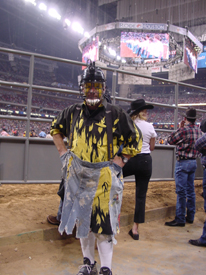Houston rodeo clown dead serious about putting TV viewers at animal eye level
Editor’s Note: Sports Technology Update couldn’t pass up the chance to find out a little bit about the rodeo clown with the POV camera mounted to his helmet in the last edition. We caught up with him near the livestock shoot on the floor of Reliant Stadium in Houston after Tuesday night’s competition to learn a little more about how and why he does what he does.

Video from Chatman’s camera is projected on six 29.5x16 foot Lighthouse LED displays suspended from the ceiling of Reliant Stadium.
The job of high-tech rodeo clown Rick Chatman is a little bit different than most.
Sure, his primary responsibility is saving bull riders from being skewered and bronc riders from being trampled, but showing rodeo fans what really goes on up close and personal with the animals and riders comes a close second.
Chatman, 47, does that with the help of a small POV (point of view) video camera mounted to his black plastic helmet, a small omni-directional microwave transmitter, wireless IFB and talkback system and a little guidance from the director calling the shots for the video production of the Houston Livestock Show and Rodeo (HLSR). Video from Chatman’s camera is projected on six 29.5x16 foot Lighthouse LED displays suspended from the ceiling of Reliant Stadium and shows up in rodeo coverage available to DirecTV customers on a pay-per-view basis.
To call Chatman’s camera the most unique of the 13 used to cover the rodeo is an understatement. According to HLSR broadcast and AV manager James Davidson, video from the camera is transmitted with a tiny Global Microwave Systems (GMS) transmitter and antenna unit on the back of the helmet. “A pointer on one of the camera platforms (above the stadium floor) aims the receive antenna at the clown,” he explained. Video transmitted from Chatman’s helmet cam is run through a frame synchronizer for integration in the show. IFB and a separate talkback channel are done over two audio channels also carried by the GMS unit.
Chatman, who estimates he works injured about half the time, has worn the camera helmet for the past nine years. During that time, he’s been stepped on, knocked over, beaten and bruised by amazingly strong and angry bulls and horses. And rodeo fans have been with him every step of the way thanks to the POV camera.
The professional video industry's #1 source for news, trends and product and tech information. Sign up below.

To train himself to frame shots properly when he first began using the POV camera, Chatman affixed plastic ties to his helmet’s face screen to create a rectangle before his eyes that conformed to what the camera saw.
“I guess the reason we do this,” he said, “is to show the fans what it’s really like and to sell more tickets.”
To train himself to frame shots properly when he first began using the POV camera, Chatman affixed plastic ties to his helmet’s face screen to create a rectangle before his eyes that conformed to what the camera saw. This virtual viewfinder helped Chatman reduce unwanted shots of the dirt or the stands and compose unmatched shots of the riders and animals.
Given the unusual circumstances under which Chatman works as a cameraman, what kind of orders can the director possibly give him over the IFB? “Oh,” he said grinning, “‘Run like hell!’”
“Seriously though, he’ll call for a tight shot and tell me to hold it or to turn the camera to the left or right,” he said. “If they anticipate that a new record is about to be set, they let me know and if it happens, I’m ready to do a little extra.”
As he stands back away from the rodeo floor talking after the show, sweat smearing his clown makeup and a little winded from the last event, one wonders how long he can keep this up. “As long as I’m effective, sir. As long as I’m effective.” he said.
To read more about the Houston Rodeo visit Custom software automates rodeo scoring at Houston Livestock Show and Rodeo.
